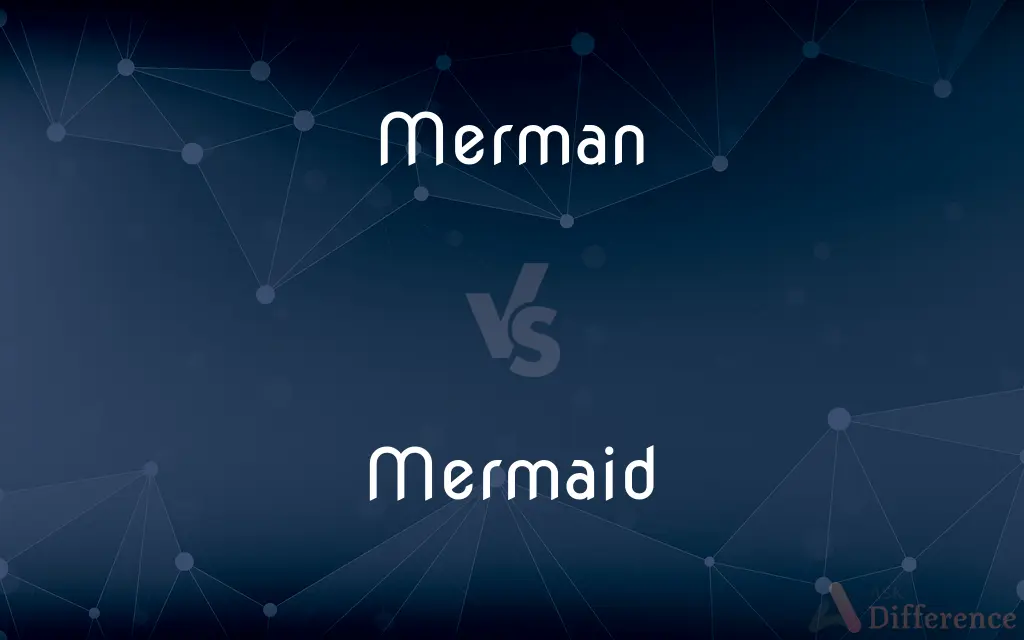Merman vs. Mermaid — What's the Difference?
Edited by Tayyaba Rehman — By Maham Liaqat — Updated on March 15, 2024
A merman is a mythical male figure with a human upper body and a fish tail, while a mermaid is the female counterpart, often depicted with long hair and beauty, both embodying sea lore.

Difference Between Merman and Mermaid
Table of Contents
ADVERTISEMENT
Key Differences
Mermen are mythological creatures described as having the upper body of a human male and the lower body of a fish. Historically, they're less commonly featured in folklore and art compared to their female counterparts. On the other hand, mermaids are widely represented in various cultures worldwide, often portrayed as beings of great beauty and allure, with their stories focusing on interactions with humans and their sometimes benevolent, sometimes malevolent, nature.
In tales and myths, mermen are often depicted as powerful and sometimes ominous figures of the sea, embodying the treacherous and unpredictable nature of the ocean. They are known to have a commanding presence, ruling over sea creatures and embodying the strength of the ocean. Mermaids, however, are frequently characterized by their enchanting beauty, singing voices capable of bewitching sailors, and a more nuanced relationship with humanity, ranging from guiding lost ships to luring men into the depths.
Culturally, mermen have not been as prominent in popular media and literature as mermaids. The mermaid's image has been romanticized and featured extensively in stories, movies, and folklore, symbolizing both the peril and wonder of the sea. Mermen, while part of the same mythological family, are less visible in such narratives, often taking on more background roles or being associated with the more fearsome aspects of the sea.
The representation of mermen and mermaids also diverges in symbolism. Mermen are sometimes seen as symbols of the untamed, wild aspects of the ocean, representing depth, power, and mystery. In contrast, mermaids often symbolize the allure and danger of the unknown, embodying beauty, grace, and sometimes a perilous temptation that leads sailors astray.
Despite their differences, both mermen and mermaids hold a fascination for the maritime and embody the human connection to the mysterious and vast oceans. They serve as metaphors for the dual nature of the sea—its beauty and bounty, and its capacity for danger and destruction.
ADVERTISEMENT
Comparison Chart
Definition
Mythical creature with a male human upper body and fish lower body.
Mythical creature with a female human upper body and fish lower body.
Cultural Representation
Less common in folklore, often depicted as powerful and ominous.
Widely represented, known for their beauty, singing, and complex interactions with humans.
Symbolism
Power, mystery, the untamed aspect of the ocean.
Beauty, temptation, the allure and danger of the unknown.
Role in Media
Less prominent, often associated with strength and the fearsome aspects of the sea.
Highly romanticized, featuring prominently in stories and films as enchanting beings.
Interaction with Humans
Varied, less frequently involved in human affairs in tales.
Often involved in human affairs, from guiding to deceiving or loving humans.
Compare with Definitions
Merman
Symbolizes the strength and mystery of the sea.
The sculpture of the merman embodied the untamed nature of the ocean.
Mermaid
Known for their enchanting beauty and melodious voice.
The mermaid's song is said to lure sailors to their doom.
Merman
Less commonly featured in modern pop culture than mermaids.
Unlike mermaids.mermen rarely headline in animated films or fairy tales.
Mermaid
Symbolizes the allure and danger of the sea.
The mermaid in the painting captured the dual nature of the ocean's beauty and peril.
Merman
Often depicted as rulers of the underwater world.
In the legend.the merman commanded the sea creatures during the storm.
Mermaid
Frequently appears in folklore and popular culture.
Mermaids are a popular subject in children's fairy tales and movies.
Merman
A mythical sea creature with the upper body of a man and the tail of a fish.
The ancient mariner spoke of a merman ruling the ocean depths.
Mermaid
Often depicted with a nuanced relationship with humans.
The mermaid fell in love with a human, bridging the world of the sea and land.
Merman
Represents a masculine aspect of sea lore.
The merman in the story represented the formidable power of the sea.
Mermaid
A mythical sea creature with the upper body of a woman and the tail of a fish.
The sailor claimed he was saved by a mermaid during the shipwreck.
Merman
Mermen, the male counterparts of the mythical female mermaids, are legendary creatures, which are male human from the waist up and fish-like from the waist down, but may assume normal human shape. Sometimes they are described as hideous and other times as handsome.
Mermaid
In folklore, a mermaid is an aquatic creature with the head and upper body of a female human and the tail of a fish. Mermaids appear in the folklore of many cultures worldwide, including Europe, Asia, and Africa.
Merman
A legendary sea creature having the head and upper body of a man and the tail of a fish.
Mermaid
A legendary sea creature having the head and upper body of a woman and the tail of a fish.
Merman
A legendary creature, human male from the waist up, fishlike from the waist down.
Mermaid
A mythological Category:en:Mythological_creatures creature with a woman's head and upper body, and a tail of a fish.
Merman
The male corresponding to mermaid; a sea man, or man fish.
Mermaid
Coloured a brilliant turquoise.
Mermaid smoothie
Merman
United States singer who appeared in several musical comedies (1909-1984)
Mermaid
(obsolete) A prostitute.
Merman
Half man and half fish; lives in the sea
Mermaid
A fabled marine creature, typically represented as having the upper part like that of a woman, and the lower like a fish; a sea nymph, sea woman, or woman fish.
Mermaid
Half woman and half fish; lives in the sea
Common Curiosities
How are mermen and mermaids different in folklore?
Mermen are often depicted as powerful and somewhat ominous figures of the sea, while mermaids are known for their beauty, enchanting voices, and diverse roles in human-related stories.
Are mermen as popular as mermaids in stories and films?
No, mermaids are more commonly featured in stories, films, and popular culture, often as central characters, whereas mermen are less visible and typically occupy more background roles.
What is a mermaid?
A mermaid is a mythical being with a female human upper body and a fish's lower body, renowned for their beauty and often complex interactions with humans in folklore.
Can mermen and mermaids interact with humans?
Yes, both can interact with humans, but mermaids are more frequently portrayed as having direct, sometimes intimate, relationships with humans in stories.
What symbolizes a merman?
Mermen symbolize the untamed, mysterious, and powerful aspects of the ocean, representing depth, strength, and the natural forces of the sea.
What symbolizes a mermaid?
Mermaids often symbolize the dual nature of the sea—its beauty and its potential for danger—as well as themes of temptation, freedom, and transformation.
What is a merman?
A merman is a mythical creature with the upper body of a human male and the lower body of a fish, featured in various folklore and maritime tales.
Do mermen and mermaids have special powers?
Many tales attribute special powers to these creatures, such as controlling elements of the sea, shape-shifting, and enchanting humans with their voices.
Are there any famous mermaid stories?
Yes, one of the most famous mermaid stories is Hans Christian Andersen's "The Little Mermaid," which explores themes of love, sacrifice, and longing.
Have mermen and mermaids been part of any significant cultural or religious beliefs?
While not central to major religions, mermen and mermaids have been part of maritime cultures and folklore around the world, embodying human curiosity and fear of the sea.
Share Your Discovery

Previous Comparison
Lamp vs. Lump
Next Comparison
Dieting vs. FastingAuthor Spotlight
Written by
Maham LiaqatEdited by
Tayyaba RehmanTayyaba Rehman is a distinguished writer, currently serving as a primary contributor to askdifference.com. As a researcher in semantics and etymology, Tayyaba's passion for the complexity of languages and their distinctions has found a perfect home on the platform. Tayyaba delves into the intricacies of language, distinguishing between commonly confused words and phrases, thereby providing clarity for readers worldwide.
















































